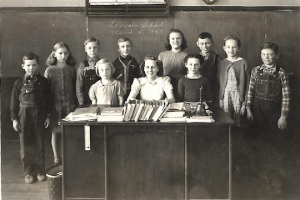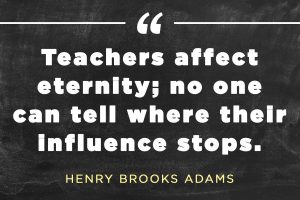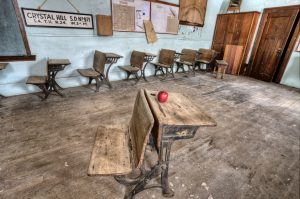The Amazing One-Room School – Revisited
In March, 2015, I had a great time writing about my life-changing experience in a one-room school, and extolling it’s virtues.
I invite you to review that post, as background.
Since then, I’ve found out what a big deal the one-room schools were, and what a great impact they had on our nation. Here’s the story.
Why And How Did One-Room Schools Get Started?
Barbara Bush, in the preface of the book America’s Country Schools, explained the “why:”
“…The pioneer families settling America’s vast frontiers understood one of Thomas Jefferson’s most deeply held convictions- that good education is the essential foundation of a strong democracy…”
And the “how” came from a Government Land Ordinance brought into being by Jefferson in 1785.
It provided for surveys that divided the land into counties, townships, and sections, with section 16 in every township set aside for education.
It was the revenue from these “education sections” that allowed states to create independent school districts and a system of free public education.
Because the people in communities voted to have a school, decided where it was built, and controlled its use, a deep sense of community and pride developed around the one-room schools.
This closeness and bonding in small communities across the land had a tremendous influence on the development of this nation.
How Many One Room Schools Were There?
When I walked in the door of Prairie View School in September, 1939, I thought I was one little kid entering first grade at my unique little one-room school.
All you have to do to see that Prairie View school was not unique, is to look at it (small blue arrow) and all the other one room schools (small orange squares) on the map below of DeWitt County, Illinois, below. (Click on the map to make it larger. Click on the left arrow at the top of the screen to return to the post.)
There were 7 one-room schools in Nixon Township where I lived (blue outline), and 90 one-room schools in DeWitt County!
There are 102 counties in Illinois, most of them larger than Dewitt.
So it is easy to estimate that there were around 10,000 one-room schools in the State of Illinois.
At the peak of the one-room school phenomenon, it was estimated that there were over a quarter of a million one-room schools in the United States. My little unique school, indeed!
A Tidbit Of One-Room School History
Just after the Civil War (1865), The One-Room Little Red Schoolhouse was very popular, and became a national icon.
A well-known newspaper said, “Next to the Flag, the Little Red School House is a significant sign of our country.”
But before the Little Red Schoolhouses got a good head of steam, an influential lady from Georgia said that, no matter if red paint is cheap, we should paint our schoolhouse like our house, not like our barn. And so, in the end, only 2% of U.S. schoolhouses were red.
However, this icon was not to be disposed of so easily, and became the Impetus for a “The Little Red Schoolhouse” song (1922) and movie (1935). Click the arrow to listen to the song:
So it’s no wonder that a Secretary of Education would later use the Little Red Schoolhouse as a symbol for the government’s “No Child Left Behind” program.
What About One-Room School Teachers?
At first I thought “What a coincidence!” Both my mother and my mother-in-law were one-room school teachers.
For that matter, so was my cousin Cherry, my good friend Evelyn, and several other women I know. And they were all between 16 and 21 years of age when they taught.
But come to think of it, there were 100,000 one-room schools in the broader Midwest alone, and each one had to have a teacher. But why were they all very young women?
Perhaps these two “rules for teachers” for one-room school teachers in 1915 will help you draw your own conclusions as to why many women one-room school teachers were so very young:
- You are not to keep company with men.
- You will not marry during the term of your contract.
Also, female teachers had proved they could handle the 8th grade boys, and they were cheap to hire, compared to men. So as we entered the 1900s, almost 85% of the one-room school teachers were women.
And these women were expected to be exceptional teachers, superb disciplinarians, experienced nurses, insightful counselors, their own janitors (fire the stove up every morning, carry in coal and wood, clean the floors, etc.), record keepers, school administrators, and lead extremely pious lives to serve as virtuous examples for their students and community. And all this for $60 per month (for 8 months, in 1915).
And, surprisingly, more often than not, they met these stringent expectations!
As author Wayne Fuller so aptly put it, “at the crossroads of the nineteenth and twentieth centuries, it was largely an army of young women who went out to slay the dragon of ignorance throughout the Midwest.”
And when I ponder again the fact that over 100,000 of them were on the job in the Greater Midwest alone (and a quarter of a million in the U.S.), I can see how they can be credited with positively changing the nature of our communities and our education system forever.
It was totally a very big deal — an unbelievable phenomenon!
How Did It (Should It) All End?
As we moved into the 1900s, some people thought that the one-room schools were the greatest thing since sliced bread. So they quietly used innovative approaches like group learning, meeting individual differences, learning through projects, etc. to help the 15 kids in an average one-room school really learn, and enable them to be a happy family that got a lot of attention from an excellent, loving teacher.
Other people became involved in massive nationwide educational and political arguments supporting the beliefs that in the one-room school teachers were not well trained, the teaching was rote and stilted, one teacher couldn’t handle every grade, classroom materials were lacking, and facilities were in a state of disrepair.
This second group of people won the day, and by 1938 (a year before I went to Prairie View), 19,000 one-room schools had been abandoned in the Midwest. I almost missed the one-room school boat!
And by 1960, 13 years after I left Prairie View, there were hardly any one-room schoolhouses left in the country! Less than 1% of all students attended a one-room school at that time.
So for 150 years, one-room schools played a major role in cementing communities, furthering democracy, and educating a larger percentage of the student population than in any other country in the world. Then, seemingly in a blink of the eye, they were essentially extinct.
Give Credit Where Credit is Due
Today, we look back on the one-room school era, and give credit where credit is due for the efforts of communities and teachers in educating the children of our country (including me, I might add).
Sure, some of us sometimes find ourselves engulfed in Nostalgia, and a yearning for the Good Ole Days.
But then we look at some of the wonderful things happening in our schools today, and know that changing times require educational innovation.
As a couple of wise people once said, “Nothing is probably as bad or as good as we perceive it.” And, “There is more than one way to skin a cat.”
I guess we could hang our hats on that!
What do you think? Post a comment in the box below.











Bill Hammitt
Bigness is not necessarily goodness!
Richard J. Marberry
History teaches a person why and how, in some respects, they came to their place in life. History is as recent as the last minute.
I’d rater have red and I’m not crazy about skinning cats, why not skunks like the one around our house.
Jim Ploeger
I visited several 1 room school house where my mother was teaching. Getting into trouble more than once. These days when my school was off left Mom no choice but to haul her kids with her to school. She had many kids go on to the U of I and one became an Illinois Senator. She was a good tough teacher.
Phares O'Daffer
Jim, that’s very interesting, and impressive. I love to hear stories about
people’s one room school experiences. Thanks for responding.
Donald Swaar
I credit my one room school and my teacher with a great deal of my success later in life.